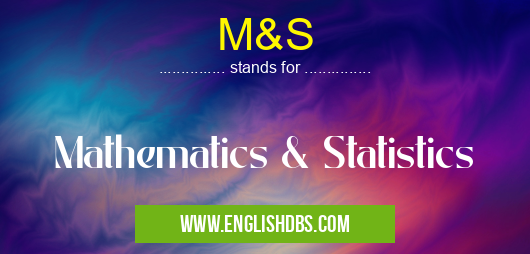What does M&S mean in STATISTICS
M&S stands for Mathematics and Statistics, which are two closely related fields of scientific study. Mathematics deals with the study and manipulation of numerical data, while Statistics involves the analysis of such data in order to draw conclusions about a given situation or population. Together they form an important part of most scientific research projects, and are becoming increasingly essential components in our ever-growing digital world.

M&S meaning in Statistics in Academic & Science
M&S mostly used in an acronym Statistics in Category Academic & Science that means Mathematics & Statistics
Shorthand: M&S,
Full Form: Mathematics & Statistics
For more information of "Mathematics & Statistics", see the section below.
What it Means
Mathematics is the science that deals with numbers, equations, functions, and their application in different contexts. It is also used to develop predictions and test theories about physical phenomena. Statistics is a branch of mathematics concerned with collecting, analyzing, and interpreting data from experiments or surveys in order to draw conclusions from them. It strives to present data in ways that are easy to interpret by humans without being overly complex or abstract. M&S can be combined to form powerful analytical tools, such as linear regression models or machine learning algorithms, that can be used for decision-making purposes across multiple disciplines.
What it Does
Mathematics and Statistics are fundamental components in many areas across the Sciences. Applied mathematics allows us to estimate parameters related to physical phenomena while statistical techniques help us make predictions based on existing data sets. By combining these two fields we can create sophisticated mathematical models that allow us to better analyze complex systems such as climate change or disease spread. Additionally, M&S methods can be deployed on quantitative problems such as financial forecasting or market research tasks. These models not only help us understand existing systems but also help us design new ones based on accurate predictions.
Essential Questions and Answers on Mathematics & Statistics in "SCIENCE»STATISTICS"
What is the purpose of Mathematics & Statistics?
The primary purpose of mathematics and statistics is to identify patterns, trends, relationships, associations and develop insights from data. This allows for better decision making in almost every field such as finance, economics, healthcare etc.
How can Mathematics & Statistics help solve real-world problems?
By examining large amounts of data, it is possible to detect patterns and use those patterns to create solutions that can be applied in the real world. For example, mathematics & statistics can be used to identify correlations between certain causes and outcomes in order to predict future events or advise on the best course of action.
What are the key principles of Mathematics & Statistics?
The main principles of mathematics & statistics include data analysis/collection; probability theory; discrete mathematics; mathematical modelling; statistical inference; hypothesis testing; optimization methods; sampling techniques and regression analysis.
Where is Mathematics & Statistics used?
Mathematics & statistics are used in a variety of fields including engineering, finance, healthcare, education, social sciences and many more. They are also applied in the physical sciences such as physics or chemistry as well as in computer science.
What do you need to study Mathematics & Statistics?
In order to study mathematics & statistics effectively one must have a strong understanding of algebraic equations, calculus and basic logic concepts. Moreover some knowledge on probability theory and stochastic processes may also be necessary depending on the field one wishes to pursue.
Are there any specific skills needed for studying Mathematics & Statistics?
Yes, being able to think analytically is essential when working with numbers and data sets. Additionally problem-solving skills will help students understand complex mathematical models or theories quickly while conducting their research or assignments accurately. Furthermore having good communication skills will enable them to explain their findings effectively to others who may not have the same level of expertise.
Final Words:
In summary, M&S stand for Mathematics & Statistics which are two closely intertwined branches of Science used together for powerful descriptive and predictive analytics purposes across many disciplines including Medicine, Economics, Engineering and more recently Artificial Intelligence applications. The possibilities created by combining these two fields are vast and open up opportunities for innovation in cutting edge technologies.
